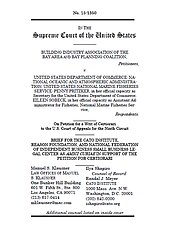Building Industry Assoc. of the Bay Area v. U.S. Dep’t of Commerce
Learn more about Cato’s Amicus Briefs Program.
“It is not rational, never mind ‘appropriate,’ to impose billions of dollars in economic costs in return for a few dollars in health or environmental benefits,” the Supreme Court held last year in Michigan v. EPA.It seems that the U.S. Fish and Wildlife Service (USFWS) did not get the message, with its willy-nilly imposition of significant economic costs when designating “critical habitat” for endangered species. A California builders’ association is now asking the Court to establish that judicial review is available for individuals and businesses affected by these agency actions that purport to enforce the Endangered Species Act (ESA). The ESA specifically requires federal agencies to take economic impacts into consideration, but the USFWS routinely ignores the costs of designating land as a critical habitat. The San Francisco-based U.S Court of Appeals for the Ninth Circuit held that the designation of critical habitat is an action fully committed to agency discretion, and that it may ignore any cost implications at its leisure, but this would seem to contradict Michigan v. EPA and other precedent. The USFWS employs a cost-benefit accounting method called “baseline analysis,” which separates the impacts that would occur absent designation (baseline impacts) from the impacts attributable to designation (incremental impacts). It then only considers the incremental impacts, despite enormous disparities between baseline and incremental costs—one order of magnitude or two—and fanciful estimates that the economic impact of critical habitat designation is often $0. Cato, joined by the Reason Foundation and National Federation of Independent Business, filed an amicus brief urging the Supreme Court to take up this important question of whether courts can even review the government’s Enron-style of cost-benefit analysis. Independent research by Reason’s Brian Seasholes found that in examining 159 of the 793 species that have critical habitat designation, there are at least $10.7 billion in economic impacts, hundreds of jobs lost per species designated, and regulatory burdens affecting 60,169,546 acres of land (11,261,054 privately owned) spanning 37 states and two territories. And what is the purported conservation benefit to these billions in costs? Nothing. As the USFWS itself has stated, “[i]n 30 years of implementing the Act, the Service has found that the designation of statutory critical habitat provides little additional protection to most listed species, while consuming significant amounts of available conservation resources.” Moreover, critical habitat designation is counterproductive for conservation. Again, the federal government is the source for the best material on this: “Mounting evidence suggests that some regulatory actions by the Federal government, while well-intentioned and required by law, can (under certain circumstances) have unintended negative consequences for the conservation of species on private lands.” These negative consequences are caused by the ESA’s regulatory reach and severe penalties—up to $50,000 and 1 year in jail for misdemeanor harm to an endangered fish, bird, or habitat, whether the habitat is occupied or not—coupled with the ability to regulate vast amounts of land, water and natural resources. As Australian environmental-law expert David Farrier has described, “disgruntled landowners make poor conservationists”—and foisting enormous costs and regulatory burdens onto homeowners with criminal penalties for non-compliance certainly makes them disgruntled.
